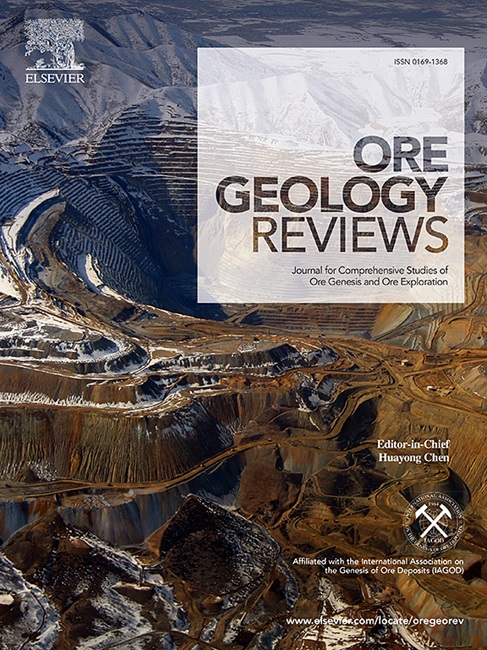Formation of the Huxingshan tungsten deposit by pulsed magmatic-hydrothermal fluids: Insights from scheelite mineral assemblage, texture, and trace elements
IF 3.6
2区 地球科学
Q1 GEOLOGY
引用次数: 0
Abstract
The Huxingshan tungsten deposit, located in the Jiangnan tungsten belt of South China, consists of scheelite-quartz-muscovite-calcite (SQMC) and scheelite-quartz-muscovite-fluorite (SQMF) vein-type mineralization hosted by the Yalan-Yuantang fault and the Niutitang Formation carbonate rocks. The textures and compositions of Sch-A (from SQMC veins) and Sch-B (from SQMF veins) were revealed by cathodoluminescence (CL) imaging and in situ LA-ICP-MS to decipher the nature and origin of the ore-forming fluids. CL images show that Sch-A is homogeneous, while Sch-B exhibits oscillatory zoning. The presence of quartz-muscovite assemblages in both vein types—common in greisen and vein-type W-Sn deposits—and the LREE-enriched patterns in Sch-A/Sch-B cores jointly indicate a magmatic-hydrothermal origin for the ore-forming fluids. However, Sch-A and Sch-B exhibit different REE patterns and yield two markedly distinct compositional clusters, with Sch-B having lower Sr, Nb, Mo, and higher Mn and REE contents than Sch-A. These mineral chemical differences, combined with the fact that fluorite exclusively occurs in Sch-B-bearing SQMF veins, suggest that Sch-A and Sch-B formed from two distinct magmatic-hydrothermal fluid pulses: a F-poor pulse and a F-rich pulse. The cores of Sch-A and Sch-B provide the earliest records of the two mineralizing fluid pulses, showing that (1) both fluid pulses initially exhibited LREE-enriched patterns, with the F-rich fluid pulse having lower LREE/HREE ratios than the F-poor fluid pulse, and (2) the F-poor fluid pulse is Sr-rich and REE-poor, while the F-rich fluid pulse is Sr-poor and REE-rich. The shift from LREE-enriched to MREE-enriched patterns from core to rim in Sch-A and Sch-B grains, accompanied by progressively decreasing REE and Sr contents, results from closed-system crystallization of scheelite during the two mineralization pulses. Sch-A and Sch-B have low Mo content (4.9–203 ppm) with variable Eu anomalies (0.56–2.89 for Sch-A and 0.87–4.21 for Sch-B), similar to those of scheelite from reduced skarn, indicating reduced conditions of the ore-forming fluids. Based on published geochronological data of the Huxingshan district, the overlapping Y/Ho ratios of both scheelite types indicate the mineralizing fluid pulses were likely sequentially released from a concealed granitic magma system emplaced at ca. 132.9 Ma. Our study at Huxingshan reveals that pulsed ore formation by multiple magmatic-hydrothermal fluid pulses is likely crucial for the formation of intrusion-related tungsten deposits.

脉冲岩浆-热液作用下虎兴山钨矿床的形成:来自白钨矿组合、结构和微量元素的启示
虎星山钨矿位于华南江南钨矿带,由白钨矿-石英-白云母-方解石(SQMC)和白钨矿-石英-白云母-萤石(SQMF)脉状矿化组成,受鸭蓝-元塘断裂和牛蹄塘组碳酸盐岩的控制。利用阴极发光(CL)显像和原位LA-ICP-MS对矿脉中Sch-A和sq - mf矿脉中Sch-B的结构和组成进行了分析,揭示了成矿流体的性质和成因。CL图像显示Sch-A是均匀的,而Sch-B则呈现振荡带。石英-白云母组合在黄铁矿和脉状钨锡矿床中普遍存在,而在Sch-A/Sch-B岩心中富集低稀土元素,表明成矿流体为岩浆-热液成因。然而,Sch-A和Sch-B表现出不同的REE模式,并产生两个明显不同的组成簇,其中Sch-B的Sr、Nb、Mo含量低于Sch-A, Mn和REE含量高于Sch-A。这些矿物化学差异,再加上萤石只存在于含含氟-b的SQMF脉中,表明Sch-A和Sch-B是由两个不同的岩浆热液脉冲形成的:贫氟脉冲和富氟脉冲。Sch-A和Sch-B岩心提供了两种成矿流体脉冲的最早记录,结果表明:(1)两种流体脉冲最初均表现为富集LREE模式,富f流体脉冲LREE/HREE比值低于贫f流体脉冲;(2)贫f流体脉冲富sr贫ree,富f流体脉冲富sr贫ree。在两次矿化过程中,白钨矿的闭合系统结晶作用导致了白钨矿由核向边缘由低REE富集向mree富集转变,同时REE和Sr含量逐渐降低。Sch-A和Sch-B的Mo含量较低(4.9 ~ 203ppm), Eu异常变化(Sch-A为0.56 ~ 2.89,Sch-B为0.87 ~ 4.21),与还原矽卡岩白钨矿相似,表明成矿流体条件降低。根据虎星山地区已发表的年代学资料,两种白钨矿类型的Y/Ho比值重叠表明,成矿流体脉冲可能是在约132.9 Ma的隐伏花岗质岩浆体系中先后释放的。虎星山的研究表明,岩浆-热液流体多脉冲脉冲成矿可能是侵入型钨矿床形成的关键。
本文章由计算机程序翻译,如有差异,请以英文原文为准。
求助全文
约1分钟内获得全文
求助全文
来源期刊

Ore Geology Reviews
地学-地质学
CiteScore
6.50
自引率
27.30%
发文量
546
审稿时长
22.9 weeks
期刊介绍:
Ore Geology Reviews aims to familiarize all earth scientists with recent advances in a number of interconnected disciplines related to the study of, and search for, ore deposits. The reviews range from brief to longer contributions, but the journal preferentially publishes manuscripts that fill the niche between the commonly shorter journal articles and the comprehensive book coverages, and thus has a special appeal to many authors and readers.
 求助内容:
求助内容: 应助结果提醒方式:
应助结果提醒方式:


